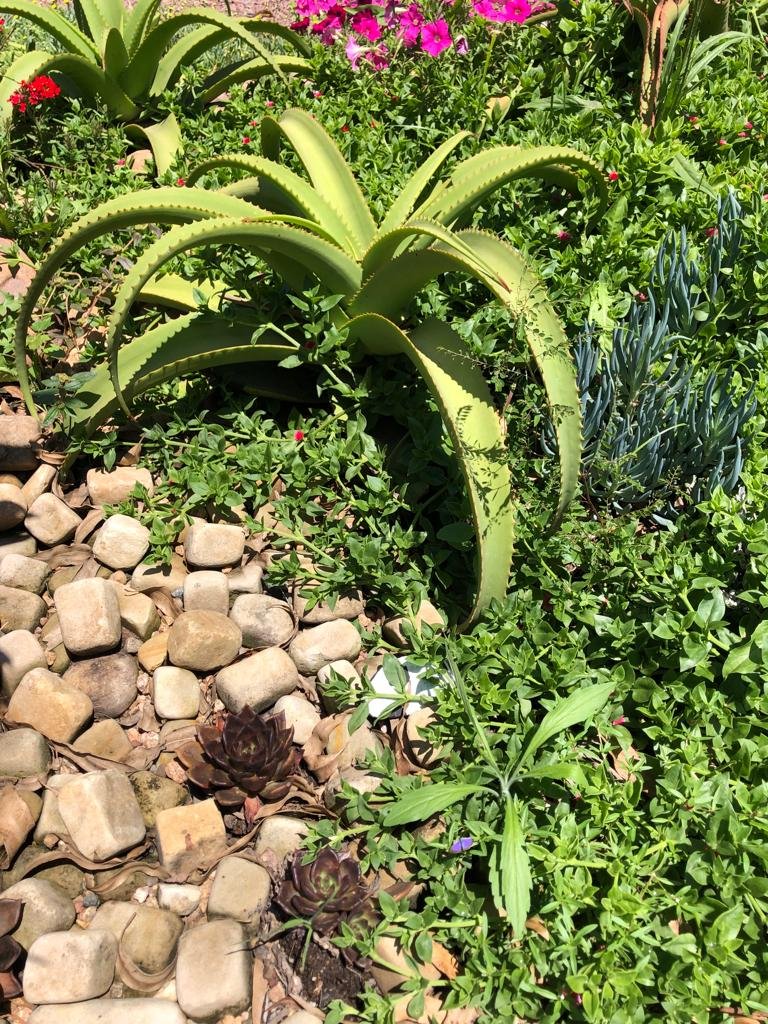 Well placed garden lighting can add an interesting dimension and transform your garden after sunset. We love and nurture our gardens during the day but tend to disappear indoors as soon as the sun sets. Lighting will not only extend the time spent in the garden, but can also highlight garden features, special plants and walkways as well as create an enchanting mood and keeping your home secure.
Well placed garden lighting can add an interesting dimension and transform your garden after sunset. We love and nurture our gardens during the day but tend to disappear indoors as soon as the sun sets. Lighting will not only extend the time spent in the garden, but can also highlight garden features, special plants and walkways as well as create an enchanting mood and keeping your home secure.
Courtyard Lighting
Energy Saving Lighting
Energy saving is always the top of our list to suit our pocket and also to aid in saving our environment .The ideal energy saving products to use are LED lamps which have a very low consumption of power and long life globes for cost effective maintenance. Solar lights are the ultimate in electricity saving. They are also easy to install. The brightness of the light is determined by the wattage of the LED's and their quality. Consider carefully where the solar lights are placed; they need at least four hours of direct sunlight to run optimally at night.
A fibre optic system and LED strips are another energy saving option. They are safe to use around water features.
Whether you decide on electricity or solar power to lighten up your life, remember the key to successful garden lighting is a soft and subtle approach. A few well chosen fittings positioned creatively are all you need to enjoy your enchanting garden once the sun has set.
Positioning Your Lights
Before deciding on lighting positions, arm yourself with a torch and set off for a night's walk around the garden to see what you'd like to illuminate. You may have a significant tree, a specimen plant or cycad, a pathway, water or garden feature that would look magnificent with the right lighting.
 Part of the garden lighting design process is about choosing and applying creative garden lighting effects to these especially selected areas. There is a fine line between creating an "atmosphere "by using lighting verses creating a GLARE. So to keep on the "atmosphere" side of the line, consider the following before positioning your lights:
Part of the garden lighting design process is about choosing and applying creative garden lighting effects to these especially selected areas. There is a fine line between creating an "atmosphere "by using lighting verses creating a GLARE. So to keep on the "atmosphere" side of the line, consider the following before positioning your lights:
- Down lighting accurately lights the intended subject without much wasted light
- Consider your neighbours when positioning up lighters
- Link you lights to a timer, which ensures a welcome and safe arrival after sunset and considerate to all after bed time.
- Place light fixtures low to the ground to illuminate pathways and steps, which will make them more attractive and provide a safer well lit, walk way.
- Conceal light fittings behind foliage, plants or rocks, this adds to the magic of lighting.
- Adjust the angle of the light until you have found the ideal positioning.
- Avoid excessive brightness near seating areas.
- Avoid light pollution also known as photo pollution or luminous pollution by concentrating on the effect being soft and subtle.
- A practical idea would be to draw a plan so that in years to come you will know exactly where cables have been placed and alert all people who work in your garden to their location.
Lawn Tips
Give your lawn a last feed before winter, to help it through. Mow your lawn only when you need to and remember to raise the blades on your mower. You only ever want to mow one third of the leaf off at a time. Any more than that will cause large brown patches. WHAT'S HOT:Feeding your soil with compost and fertiliser
WHAT'S NOT:Planting water thirsty plants where they get the hot afternoon sun
Transplanting Tips
 If you need to relocate established trees and shrubs to a more suitable position in your garden, Autumn is the best time to do it.
Tip 1: In preparation for the big move, always prune trees and shrubs before digging them out, this helps to minimize transplant shock, this gives them a much better chance to make a rapid recovery in their new home.
If you need to relocate established trees and shrubs to a more suitable position in your garden, Autumn is the best time to do it.
Tip 1: In preparation for the big move, always prune trees and shrubs before digging them out, this helps to minimize transplant shock, this gives them a much better chance to make a rapid recovery in their new home.
Tip 2: Prepare the new hole before you even start digging the tree or shrub out. Good hole preparation is key. A general rule for a medium sized tree (of about a man's height) is to dig a 1m x 1m hole and about 800mm deep. Now that is a lot of digging, but worth the effort when you see your tree flourishing. Mix the soil that has come out of the hole with generous amounts of compost, bone meal and a general fertilizer.
Tip 3: Very important when transplanting any plant, is to firmly compress the soil around the roots of the plant. You can really be quite tough about it. Even a great big stomp with your garden boots is good. Large air pockets around the roots cause the fine root hairs to dry out and causes the death of the plant.
Tip 4: The "Life and Death" tip: Never plant your tree too deep in the hole. If soil covers the stem of your tree, higher than what it was in its original position... IT WILL DIE.
Water Wize Quick Tip
Combine aloes and succulents together in a well thought out garden bed or rockery. Watering will be required but intermittently.
Balancing the scales between Predator & Pests
 I have been stumbling across all sorts of insects in the garden this past month. One garden had a whole swarm of grasshoppers that seemed to be grazing their way through, from one corner to the other; some coral trees have been alive with nice big juicy caterpillars. The coral tree I was focusing on was oozing caterpillars; some had fallen on the ground beneath the tree and had formed a live squirming carpet. Rubbing shoulders with the caterpillars were a handful of plump slimy slugs! I have now been told that they were relishing in the faeces of the caterpillars! Beautifully bright butterflies have also been plentiful. When I see them I cannot help but wonder what creepy this particular beauty morphs into…(I can already see you reaching for the Doom). When I see this activity in your garden, I celebrate, as it means to me that habitat has been created and the food chain is functioning in your garden.
I have been stumbling across all sorts of insects in the garden this past month. One garden had a whole swarm of grasshoppers that seemed to be grazing their way through, from one corner to the other; some coral trees have been alive with nice big juicy caterpillars. The coral tree I was focusing on was oozing caterpillars; some had fallen on the ground beneath the tree and had formed a live squirming carpet. Rubbing shoulders with the caterpillars were a handful of plump slimy slugs! I have now been told that they were relishing in the faeces of the caterpillars! Beautifully bright butterflies have also been plentiful. When I see them I cannot help but wonder what creepy this particular beauty morphs into…(I can already see you reaching for the Doom). When I see this activity in your garden, I celebrate, as it means to me that habitat has been created and the food chain is functioning in your garden.
 The challenge to each and every gardener and homeowner is to now establish a natural balance between pests and predators in your environment. There are many invaluable predators you could attract to your garden to keep the pests to manageable proportions. Just by avoiding the use of pesticides to kill any pests one will gradually encourage helpful predators to your garden and these include chameleons, Praying Mantis, Hoverflies and ladybirds that feed on aphids; frogs, wasps, bees, bats that eat mosquitoes, lizards, centipedes and all kinds of birds. (This is where you but the Doom back in the cupboard).
The challenge to each and every gardener and homeowner is to now establish a natural balance between pests and predators in your environment. There are many invaluable predators you could attract to your garden to keep the pests to manageable proportions. Just by avoiding the use of pesticides to kill any pests one will gradually encourage helpful predators to your garden and these include chameleons, Praying Mantis, Hoverflies and ladybirds that feed on aphids; frogs, wasps, bees, bats that eat mosquitoes, lizards, centipedes and all kinds of birds. (This is where you but the Doom back in the cupboard).
Garden Hazards
 Last month our Simbithi Maintenance Manager, Warren stepped back onto a thorny branch while attending to pruning. A really large and nasty Acacia thorn embedded in his leg, at the back of his knee. A surgical procedure and five stitches later, the offending thorn was finally removed, and he has the scar to prove it! Gardening is not always a bed of roses and there are a few other garden hazards that we would like to mention that one should watch out for and avoid:
Last month our Simbithi Maintenance Manager, Warren stepped back onto a thorny branch while attending to pruning. A really large and nasty Acacia thorn embedded in his leg, at the back of his knee. A surgical procedure and five stitches later, the offending thorn was finally removed, and he has the scar to prove it! Gardening is not always a bed of roses and there are a few other garden hazards that we would like to mention that one should watch out for and avoid:

- Thorny, spiky and poisonous plants
- Exposed tree roots
- Chipped or uneven pavers
- Ends of stakes (cover with a cork)
- Unprotected water like bird baths, ponds and water features for small children
- Slippery paving and mossy soil in shaded areas
- Gardening tools (especially hard rakes) that have not been packed away.






